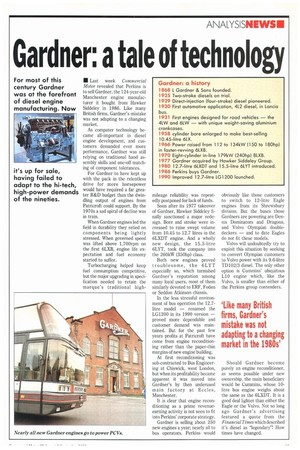Gardner: a tale of technology
Page 15

If you've noticed an error in this article please click here to report it so we can fix it.
• Last week Commercial Motor revealed that Perkins is to sell Gardner, the 124-year-old Manchester engine manufacturer it bought from Hawker Siddeley in 1986. Like many British firms, Gardner's mistake was not adapting to a changing market.
As computer technology became all-important in diesel engine development, and customers demanded ever more performance, Gardner was still relying on traditional hand assembly skills and one-off matching of component tolerances.
For Gardner to have kept up with the pack in the relentless drive for more horsepower would have required a far greater R&D budget than the dwindling output of engines from Patricroft could support. By the 1970s a sad spiral of decline was in train.
When Gardner engines led the field in durability they relied on components being lightly stressed. When governed speed was lifted above 1,700rpm on the first 6LXB, engine life expectation and fuel economy started to suffer.
Turbocharging helped keep fuel consumption competitive, but the major upgrading in specification needed to retain the marque's traditional high
mileage reliability was repeatedly postponed for lack of funds.
Soon after its 1977 takeover of Gardner, Hawker Siddeley finally sanctioned a major redesign. Bore and stroke were increased to raise swept volume from 10.45 to 12.7 litres in the 6LXDT engine. And a wholly new design, the 15.5-litre 6LYT, took the company into the 260kW (350hp) class.
Both new engines proved troublesome, the 6LYT especially so, which tarnished Gardner's reputation among many loyal users, most of them similarly devoted to ERF, Foden or Seddon Atkinson chassis.
In the leas stressful environment of bus operation the 12.7litre model — renamed the LG1200 in its 1990 version — proved more dependable and customer demand was maintained. But for the past few years profits at Patricroft have come from engine reconditioning rather than the paper-thin margins of new engine building.
At first reconditioning was sub-contracted to Bus Engineering at Chiswick, west London, but when its profitability became apparent it was moved into Gardner's by then underused main factory at Eccles, Manchester.
It is clear that engine reconditioning as a prime revenueearning activity is not seen to fit into Perkins' corporate strategy.
Gardner is selling about 250 new engines a year; nearly all to bus operators. Perkins would
obviously like those customers to switch to 12-litre Eagle engines from its Shrewsbury division. But the buses those Gardners are powering are Dennis Dominators and Dragons, and Volvo Olympian doubledeckers — and to date Eagles do not fit these models.
Volvo will undoubtedly try to exploit this situation by seeking to convert Olympian customers to Volvo power with its 9.6-litre TD102/3 diesel. The only other option is Cummins' ubiquitous L10 engine which, like the Volvo, is smaller than either of the Perkins group contenders.
Should Gardner become purely an engine reconditioner, as seems possible under new ownership, the main beneficiary would be Cummins, whose 10litre bus engine weighs about the same as the 6LXDT. It is a good deal lighter than either the Eagle or the Volvo. Not so long ago Gardner's advertising featured a quote from the Financial Times which described it's diesel as legendary"! How times have changed.








































































